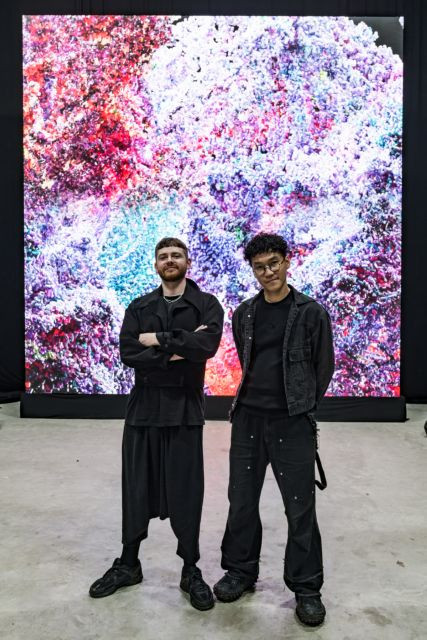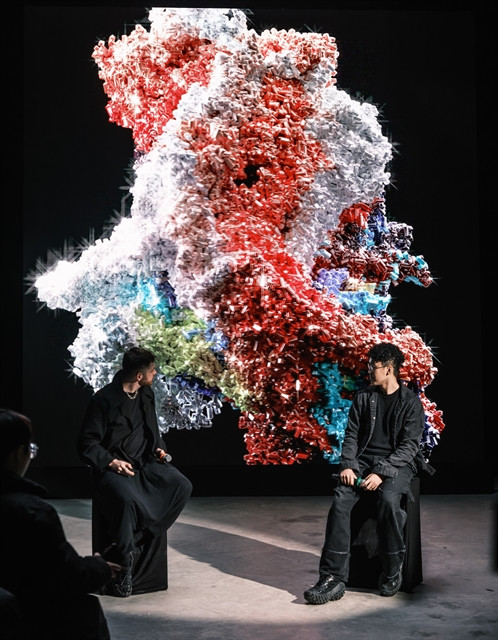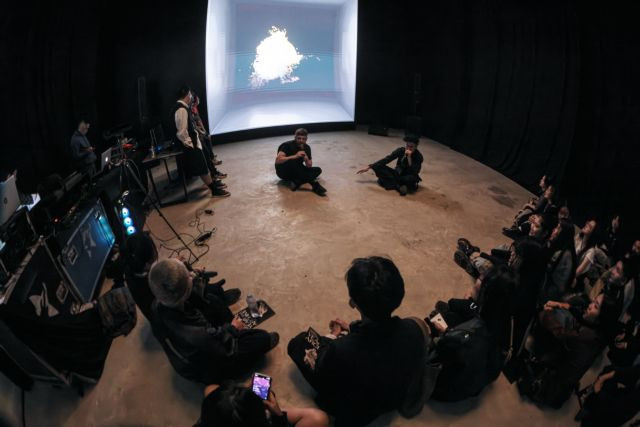AI drives a new wave of tech revolution, which is feared to replace humans and tradition. It is believed technology could eradicate artists' creative efforts and ingenuity with the emergence of generative art – algorithms and automated systems that can create artworks.
However, UK new-media artist and technologist Harry Yeff — better known by his stage name Reeps100 — and Vietnamese new-media artist Nguyễn Bảo Trung, also known as Trung Bảo, do not think technology poses a threat.
 |
| Harry Yeff (left) and Nguyễn Bảo Trung at the introduction of Voice Gems: 1000 Years of Archives in Hà Nội. Photo courtesy of 84NOISE. |
“If we can cooperate with technology and AI to uncover new ways of highlighting the significance of human experience, we can turn the ‘narrative of fear’ into the ‘narrative of hope',” Yeff said.
As the world's leading vocal experimentalists, Trung and Yeff regard the human voice as "the oldest instrument".
“Even before language, the human voice is the purest form of self-expression and signifies the power of communication. Human voices reveal identity, emotions and stories that we frequently ignore,” Trung said.
"The idea of using technology to highlight, preserve, and amplify human voices brings us to the new media art project Voice Gems."
Voice-generated physical gems
With a desire to experiment with technology and explore the capability of the human voice, Yeff and Trung have developed a surreal art-technology project Voice Gems – a generative system and voice archive that transforms human voices into digital gems.
This is the first time the duo introduced their forward-thinking concept and partially performed the project in Việt Nam with the support of the creative platform 84NOISE.
The Voice Gems system created by Yeff and Trung analyses unique elements of the voice including pitch, resonance, volume, timbre and emotions to produce a visualised gem. Formulated of 200,000 digital particles, each gemstone is one-of-a-kind, just as each voice is unique with fingerprint-like features.
A slow and calm voice leads to a more consistent structured gem, while someone talking fast and eagerly receives a thin structured gem. A voice with higher resonances leaves behind multicoloured gems, while the older person's voice with a lower resonance generates more neutral colours.
 |
| Yeff (left) and Trung have become two of the emerging and progressive lateral thinkers in the world of voice and technology experimentation. Photo courtesy of 84NOISE. |
Digital ceremony
The first voice gem they generated was for a man who used the sound of their laughter together as a marriage proposal gift, replacing the traditional diamond gemstone. Another time, a father wished to preserve his daughter's voice when he realised she was growing up.
Notably, the duo created stones from recordings of deceased people, such as the voice of Austrian scientist-writer Herbert W. Franke.
“We produced this voice gem just one year before he passed away. Now, the gem has a special meaning to his wife as a way to commemorate him,” Yeff said.
Transcending their initial idea of technology and voice experimentation, Voice Gems opens the door to new possibilities in preserving memories and conveying emotions – which Yeff termed a “digital ceremony”.
"Voice Gems has visualised and materialised the voice into something tactile that we can see, touch and connect with through different sensories," Trung said.
They have experimented with converting voice gems into physical works such as installations, 3D printing and cast sculptures.
Humans have always sought ways to memorialise their loved ones and events, and then convey our emotions into something tangible. With Voice Gems, Yeff and Trung are now working on developing a ground-breaking but similar experience for human voices.
A 1,000-year archive
It led to the next idea of 1,000 Years of Archives, Voice Gems' extended project, aiming to preserve the human voice and its identity for the next 1,000 years in the digital environment.
The project has archived the most remarkable, influential voices and vulnerable, endangered voices – whether they are human voices or from endangered species.
 |
| The digital voice gems from the voice of Austrian scientist-writer Herbert W. Franke, the couple's laughter and the sound of Indri indri – a critically endangered species living in Madagascar, Africa (from left to right). Photo courtesy of Voice Gems. |
Voice Gems has attracted contributions from world-class prominent figures, including contemporary artist Ai Weiwei, scientist-writer Herbert, football player Geoff Hurst, and artist Ngô Hồng Quang, among other names.
They collaborated with several institutions, including the World Economic Forum, National Geographic, and the Berggruen Institute, and showcased Voice Gems at renowned art galleries such as Koenig Gallery, Francisco Carolinum Linz, and W1 Curates.
Following up on the 1,000 Years of Archives, the duo hinted at a potential long-term project to collect and preserve the voices of Vietnamese, especially Vietnamese ethnic minorities.
As an artist who always creates a unique blend of tradition and modernity in his artworks, Trung found passion in this project.
“I think our mother tongue, the Vietnamese language, is somehow taken for granted,” he said.
Yeff added: “We wish to possibly open a big-scale exhibition in Hà Nội soon and welcome audiences to more multidimensional artistic experiences.”
 |
| The duo showcase an open lab for Voice Gems real-time performance system. Photo courtesy of 84NOISE. |
As it employs the latest language – programming language, new media art potentially rises to the top of the global creative arena.
Lê Minh Quân, the founder of 84NOISE, highlighted the event as an effort to integrate and elevate Việt Nam's creative industries with avant-garde concepts. He hopes that the realm of Vietnamese creativity will gradually align with global movements.
“New media art is still an unexplored but potential aspect in Việt Nam,” Quân said.
“By presenting this futuristic art project, I hope that Vietnamese contemporary artists will catch the technology wave without being wiped out and amplify it as a part of the community culture in the future.” VNS